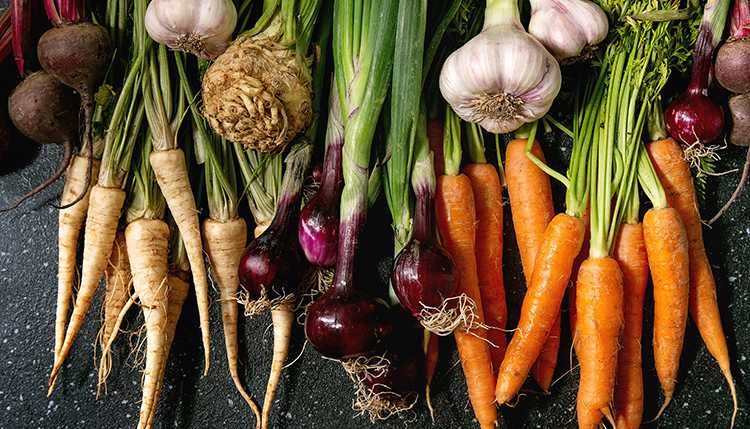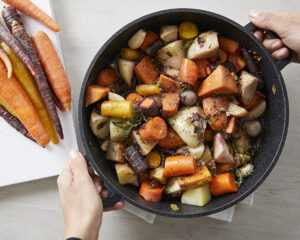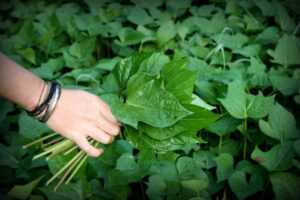December 21
From this point onward
Darkness will decrease
And the light will increase.
Not because I made a decision
Or that this is my heart’s desire
It is simply the way of the earth and the sun.
They have been here long before me.
– Matan Porat
English Translation: Aliza Raz-Melzer
_______________________
In these stormy, turbulent times we face, I find solace in the field. The simple renewal of nature and growth, completely indifferent to human chaos, calms me. And I try to learn from Mother Nature. I look at the plants that cling to the earth with healthy, branching roots, and I recall my own strong roots embedded in the soil of this country and the life upon it. So, this week: a reflection on roots…
Winter is at its peak, just the time to curl up deep inside your blankets, keep warm, and garner strength for the spring activities waiting in the wings. Lots of Chubeza’s veggies share this feeling as well. Winter in the vegetable beds is characterized by juicy, sweet root vegetables, dug deep within the soil which protects them from fierce rain and winds. These warm, comfy quarters provide the plant with stability, support, and crucial nutrients.
The root vegetables’ proximity to the earth and their task as a storehouse make them particularly rich in vitamins and minerals (stored in the plant for its own interests, but we end up the winners) and rich in hearty, viable flavor. Sweet like the sweet potato, carrot and beet, or sharp like the radish. Interestingly, the temperature affects the potency of vegetables in different ways: cool weather heightens the sweetness of carrots and beets, but makes the radishes milder. Go figure…
The texture of root vegetables also varies from that of vegetables growing from other parts of the plant above ground. Root vegetables are harder and more compressed than the greens, inflorescence, or the fruits of the plant. Their mission is to stabilize the plant in the soil. Roots hold everything that will grow above ground, which is why they express determination in their compressed growth. And that is exactly what we, their happy gobbler-uppers, need: produce rich in dietary fiber that cleanses our intestines, providing comfort and a warm, satiated feeling on a rainy, windy day.
So, let’s get acquainted with the champion carrots, beets, sweet potatoes, radishes and turnips, celery and parsley roots, Jerusalem artichokes, onions, leeks and garlic. Who’s not included in this impressive list? The potato, of course. Though it grows underground, it is not a root but rather a stem that thickened into a tuber. The kohlrabi and fennel, sometimes mistaken for roots, are in fact chubby stems that grow very close to the soil from above… And yet, despite their not being botanically-certified roots, potatoes, kohlrabi and fennel share many similarities with root vegetables, and they receive similar treatment in the kitchen.
In Chinese medicine, root vegetables belong to the element of earth, where they grow, develop, and store the earth’s energy. This is why root vegetables are considered to fortify the organs associated with the earth element: the spleen and stomach. Just like earth, where the nutrients dissolve into water which nourishes the plant to enable its growth and development, these are the organs which digest the energy-building food.
Interestingly, these vegetables begin filling out and are gathered (root vegetables are not “picked,” but rather gathered from the earth) from autumn to spring, another transitional season. The earth element symbolizes the cycles in nature and the ability to change. The womb that nourishes, the grave that buries. Like the tangible and metaphoric Mother Earth which provides nourishment, support, stability, growth, and fertility – from which we are born and to which we return. A balanced earth element enables support in times of changes, like our unstable autumn and spring.
And though it is dark underground, with presumably no reason to waste energy on interior-decorating your pad, the root vegetables come in a lovely hue of colors: white, red, purple, orange… In fact, the green, so dominant above-ground, does not exist underground, for green is the color of the chlorophyll pigment which sunlight turns to green. But the rest of the colors hiding in the soil provide us a rainbow of health benefits in the form of valuable components that strengthen us. The orange beta and alpha-carotene, along with other carotenoids (in carrots and sweet potatoes), red lycopene (in various radishes), the white allicin (in onions and garlic), red polyphenols (in beets), to name just a few.
These valuable substances reside in the roots even when they are fresh and chopped up in salad. But they are much more accessible to us and better absorbed after being cooked (one more reason to praise their growth in wintertime) in a rich, hearty soup or heavenly thick stew, or baked lightly in the oven for a yummy warm snack. Just as the kingdom of the above-ground vegetables fosters a “cooking support” unit in the guise of greens and herbs that enhance flavor, fragrance and significance for each dish, so it is in the Lower World, where their underground colleagues take the form of celery roots, parsley roots and Jerusalem artichokes – not usually the pivotal element of the dish (although there are dishes in which they star), but without them the soup is just not the same. And for those who taste a dish seasoned with spice roots, any future dish without them will simply be tasteless.
Although the root is the reason that human beings expend effort into growing these vegetables, most of these root vegetables sport excellent edible leaves as well. You can use beetroot greens just as you would spinach or Swiss chard (they are cousins, and they taste similar). Add radish leaves to a salad, or as you would any other “green”– in soup, in a quiche or a sandwich, along with the radishes themselves. If you want to eat them fresh, use the tender younger leaves. Finely chop radish leaves and add to butter with lemon zest and a dash of salt to create a delicious, mildly sharp spread for your bread. Their nutritional value, like other greens, is high in vitamins and iron.
The fresh onion shoots in your boxes over the past few weeks are excellent for use as scallions. And the green garlic shoots allow us to indulge in a mild garlicy taste in a fresh salad. When garlic and onions are grown to their dry stage, they no longer have green leaves, thus the opportunity to enjoy their green delights is short and precious. The celeriac and parsley root leaves are in fact somewhat wilder, rougher versions of the familiar celery and parsley leaves. Their flavor is more potent, so add them to salads only for those who crave strong tastes. When cooked, however, they turn milder.
We’ll end this newsletter with a surprising tale: Several years ago, veteran and adventurous Chubeza clients Genevieve and Barry taught me something I didn’t know: sweet potato leaves are indeed edible! They read an article extolling cooked sweet potato greens, and the courageous couple decided to act as our guinea pigs. So, one fine harvest day we filled a bag of sweet potato leaves for them and sent it off to Tel Aviv.
After experimenting, they sent back a detailed, informative report: “We have mixed feelings. The leaves are indeed tasty, with a minty flavor. We still prefer the classics like chard and kale, and naturally we delight in chubeza greens. The sweet potato greens are also labor intensive, as they must be cut one by one from overhanging branches. We don’t think this aspect will particularly please the average Chubeza member…. But, this was an interesting experiment indeed. We now wonder if the same plants growing in a moist climate (Malaysia, for example) grow bigger, softer leaves.”
Any Malaysians out there to give us an answer?
Great thanks to our bold experimenters, but due to the outcome of the experiment, we shall not be adding sweet potato greens to your boxes in the near future.
This week, may we all connect to our sturdy, nourishing base, empowering us to stand strong and sure amidst these turbulent times.
Alon, Bat-Ami, Dror, Orin and the Chubeza team
______________________________________________________
For the past few weeks, the frigid weather has had an adverse effect on the cucumbers and tomatoes, significantly slowing down their growth. Our fellow organic farms are also lacking these vegetables. At the start of the week, we managed to pick some cucumbers and supplement with others from another grower. However, it is possible that during this week and over the near future, we will not have enough cucumbers to include them in all the boxes. Should that occur, we will supplement with sweet, delicious red bell peppers, thus boxes will contain either cucumbers or peppers. Hopefully the shortage will soon end.
WHAT’S IN THIS WEEK’S BOXES?
Monday: Daikon/turnips/baby radishes/cabbage, carrots/potatoes, lettuce/arugula, kohlrabi/fennel, cauliflower, celery/celeriac/parsley root, parsley/coriander/dill, tomatoes, cucumbers/red bell peppers.
Small boxes only: Broccoli/sweet potatoes, Swiss chard/spinach/kale/ tatsoi.
Large box, in addition: Broccoli and sweet potatoes, green or yellow string beans/snow peas/Jerusalem artichokes/green fava beans, beets, fresh onions.
FRUIT BOXES: Kiwi, oranges/clementinas, avocados, red or green apples.
Wednesday: Daikon/turnips/fennel, cauliflower/red cabbage/Jerusalem artichokes, carrots, lettuce/arugula, kohlrabi/baby radishes, celery/celeriac, parsley/coriander/dill, tomatoes, cucumbers/red bell peppers, broccoli, fresh onions.
Large box, in addition: Sweet potatoes, Swiss chard/spinach/kale, string beans/snow peas/green fava beans/beets.
FRUIT BOXES: Kiwi, oranges/clementinas, avocados, red or green apples.



